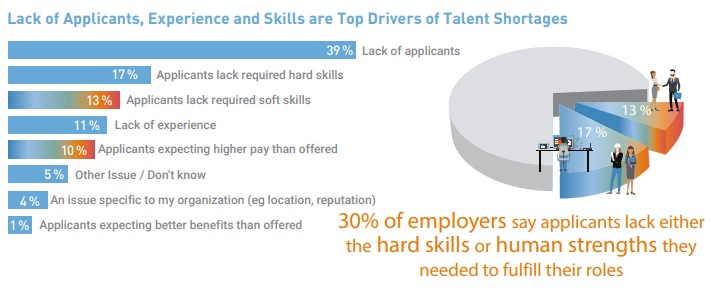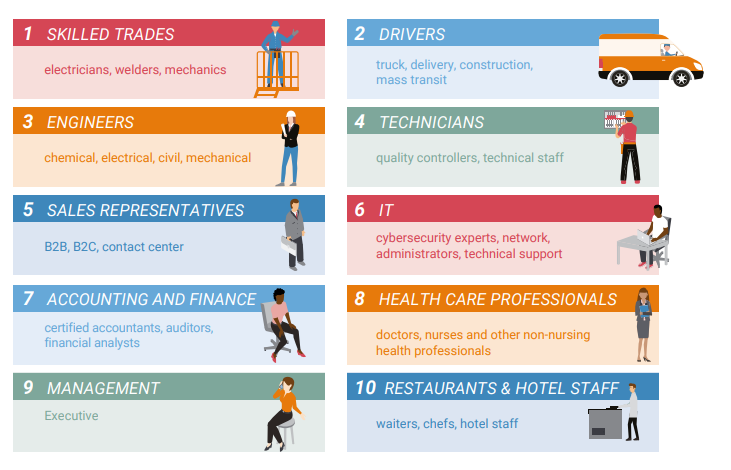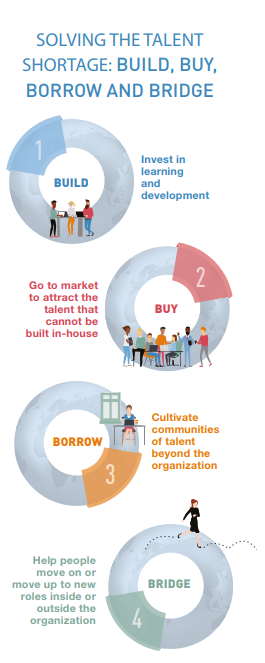
36 % employers in Czech say they can’t find the skills they need
To understand the impact companies we asked 39 195 employers in 43 countries and territorries:
- How much difficulty are you having filling roles compared to last year?
- Which skills – hard skills and human strengths – are the most difficult to find, and why?
- What are you doing to solve talent shortages?
Situation in Czech Rebublic
We found that more employers than ever are struggling to fill open jobs. 36 % say they can’t find the skills they need, and for large organizations (250+ employees) it’s even higher, with 91 % reporting talent shortages in 2018.
Global talent shortages reach 12-year high
As the global economy has steadily strengthened over the past decade, employers are more optimistic and hiring demand is stronger. Combined with changing skills needs, talent shortages have been pushed to their highest levels since our survey began in 2006.
In 2018, employers in Japan (89 %), Romania (81 %) and Taiwan (78 %) report the most difficulty filling positions, while those in the UK (19 %), Ireland (18 %) and China (13 %) report the least difficulty. In Japan, the lack of labor supply, aging demographics and immigration restrictions continue to fuel the problem, while in Romania and Taiwan it reflects the upward trajectory of nearshoring and offshoring over recent years. The result is that employers are left with unfilled roles, threatening growth and operational efficiency.
Why employers can’t find the talent they need?

One-third of employers say the main reason they can’t fill roles is a lack of applicants. Another 11% say candidates lack the necessary experience. As companies digitalize, automate and transform, finding candidates with the right blend of technical skills and human strengths is more important than ever – yet 30 % of employers say applicants lack either the hard skills or the human strengths they need. Globally, more than half (56 %) of employers say communication skills, written and verbal, are their most valued human strengths followed by collaboration and problem-solving.
The focus on customer service and last mile delivery across virtually every industry means having the right skills mix is key. Sales representatives need to be strong on product knowledge, influencing and relationship management as well as the need to use digital inventory and analytics tools, while IT functions need technical capabilities alongside people management and strong communication skills.
TOP 10 most in demand skills in the Czech Republic

While artificial intelligence is fast-expanding what can be automated, technology is redefining rather than replacing indemand roles. Skilled trades – electricians, welders, mechanics and more – as well as sales representatives, engineers, drivers and technicians have ranked among the top five hardest roles to fill for the past ten years. Demand for drivers and customer service remains strong fueled by the rise of consumerism — increasing online retail, logistics and last-mile delivery. Yet these roles are different to how they looked a decade ago and continue to change, requiring new skills and training.
Most of the top ten in-demand roles today require post-secondary training and not always a full university degree. Midskilled roles like these and others represent 40% of all jobs across the OECD3 and demand for them is growing. In the digital age, employment will not always require a college degree, but will rely heavily on continual skills development as even the most traditional roles are augmented with new technology.
The talent shortage Conundrum: What employers are doing today

In the Skills Revolution when new roles emerge as fast as others become obsolete, employers realize that what you are likely to learn is becoming more important than what you already know. Companies are beginning to tackle talent shortages by upskilling their own workforce: over half are investing in learning platforms and development tools to build their talent pipeline, up from just 45% in 2014.
BUILD, BUY, BORROW AND BRIDGE: OVERCOMING TALENT SHORTAGES IN THE FUTURE
A new talent landscape is emerging to meet the demands of the Skills Revolution. Faced with a high-change environment driven by technology, companies must create a culture of learning and put people first by developing a workforce strategy incorporating build, buy, borrow and bridge. This is how we will solve talent shortages and enable individuals and organizations to reach their potential in the digital age.
To win in the digital age an effective talent strategy should have four parts: build, buy, borrow and bridge. Build your talent pipeline, buy skills where necessary, borrow from external talent sources and bridge people with adjacent skills from one role to another to complement existing skills.
- Build – Invest in learning and development to grow your talent pipeline
- Buy – Go to external market to find the best talent that cannot be built in-house in the timeframe required
- Borrow – Cultivate communities of talent outside the organization, including part-time, freelance, contract and temporary workers to complement existing skills
- Bridge – Help people move on and move up to new roles inside or outside the organization
Jiří Halbrštát
ManpowerGroup
